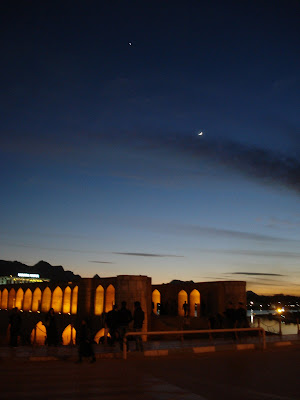Zayandeh Rud

On several occasions I have described my 2005 journey through Central Iran which took me from Tehran to the holy city of Qom, Kashan, Abyaneh and Natanz, and then again to the beautiful city of Esfahan. If there was a special coat of arms for Esfahan it should contain the very characteristic pigeon towers which can be seen when entering the wide planes of the huge city. The towers from the Safavid era in the 17th century attract large numbers of pigeons which will hatch in the towers producing lots of dung which can be collected and used as fertilizer.



The river flowing through Esfahan is not seasonal as so many others in Iran. Zayandeh Rud originates in the Zagros mountains west of Esfahan and flows to the east where it disappears after about 400 km in a salt marsh, the Gavkhouni swamp in the near-by desert. Since all the pollution of the Esfahan's larger municipality arrives here and water simply evaporates, this ecosystem is highly endangered, of course.



The river itself is incredibly charming. Esfahanians are very eager in beautifying the park-like riverbanks, and important and world-renowned Safavid bridges cross the stream. Most probably the most stunning is Si-o-se Pol (built in 1632), literally meaning 33 bridge arches.



Another one is Khaju Bridge (1650). These bridges are frequented by young and older Esfahanians, especially at night when darkness conceals romantic encounters, street musicians play, and the small tea houses in the bridge’s arches invite for having a rest and a qaliyan (the water pipe). At the eastern side of Khaju Bridge two black sculptures of lions on each of the riverbanks are watching each other. At night, reflections in their eyes can be seen from the other side of the river, almost supernaturally glowing. An architectural masterpiece of calculation and realization.







Comments